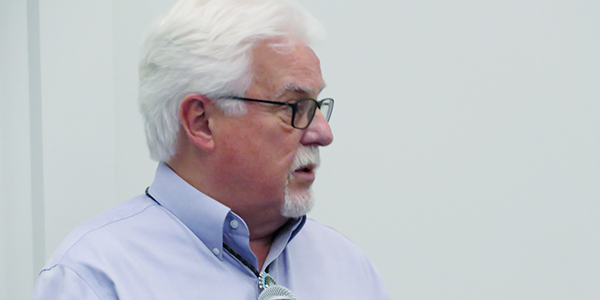By Rich Heidorn Jr.
ORLANDO, Fla. — Tim Fritch, vice chair of NERC’s Synchronized Measurements Subcommittee, said June 4 that his panel’s research into the Jan. 11 Eastern Interconnection oscillation event has identified the need to improve data sharing and provide guidance for responding to such events.

Tim Fritch, vice chair of NERC’s Synchronized Measurements Subcommittee | © ERO Insider
Fritch briefed NERC’s Planning Committee on a survey the subcommittee created to determine whether utilities were aware of the event and how they responded. NERC reported earlier that the event lasted about 18 minutes, with power swings of 200 MW around Florida and 50 MW around ISO-NE.
Eleven utilities responded to the survey, including both transmission operators and reliability coordinators, and nine said they were aware of the event. Only two utilities reported taking action in response, both taking some of their units out of automatic generation control when they were oscillating, Fritch said.
Seven of the utilities agreed there is a need to develop both a phasor measurement unit data-sharing requirement for RCs, and a real-time regional oscillation and source detection tool. The same number agreed the SMS should identify and address gaps in existing reliability standards on RC-to-RC coordination.
The event was illustrated in a video by the University of Tennessee’s FNET/GridEye tool.

Rob Cummings, NERC’s senior director of engineering and reliability initiatives | © ERO Insider
“It was hard to tell, unless you saw the very beginning of that video, who was creating the oscillation and who was responding,” said Fritch, an electrical engineer for the Tennessee Valley Authority. “And then going back and listening to RC calls, it was hard for the RC operators to understand where this all originated. So, I think we all agree this is something that needs to be addressed because a lot of these operators were essentially flying blind. Fortunately here, there were only two utilities that took action. … We know that, depending on what units were taken offline, it could have made the oscillation worse. … We need to address that and provide guidance to our operators about what to do when we have these type of events — or what not to do.”
Rob Cummings, NERC’s senior director of engineering and reliability initiatives, said that using FNET/Grid Eye “within 15 minutes I knew that it was a forced oscillation … and I also pinpointed the beginning and end to be in Tampa, Fla. So, if I could do that … the operators could too. And I’m more than willing to put together tutorials on how to determine this for the RCs.”
Fritch said the SMS would “essentially hand [the issue] off” to the Operating Reliability Subcommittee for additional discussion.



